Abstract
Weanling mice were inoculated intracerebrally with selected vesicular stomatitis virus (VSV) complementation group II and III temperature-sensitive (ts) mutants. Of the VSV ts mutants studied, only ts G32, a group III complementation mutant, appeared neurovirulent. Interestingly, neither the capacity to replicate in central nervous system tissue nor the ability to replicate in certain neurally derived continuous cell lines at semipermissive or nonpermissive temperatures appeared different among the VSV ts mutants employed. Finally, the pathological alterations in central nervous system tissue produced by VSV ts G32 were entirely different than those produced by G31 VSV ts in the group III mutant. These studies support the hypothesis that both the virological and neuropathological features produced by different VSV ts mutants are dependent upon the unique characteristics of each mutant, rather than upon a common biochemical defect shared by all members of a complementation group.
Full text
PDF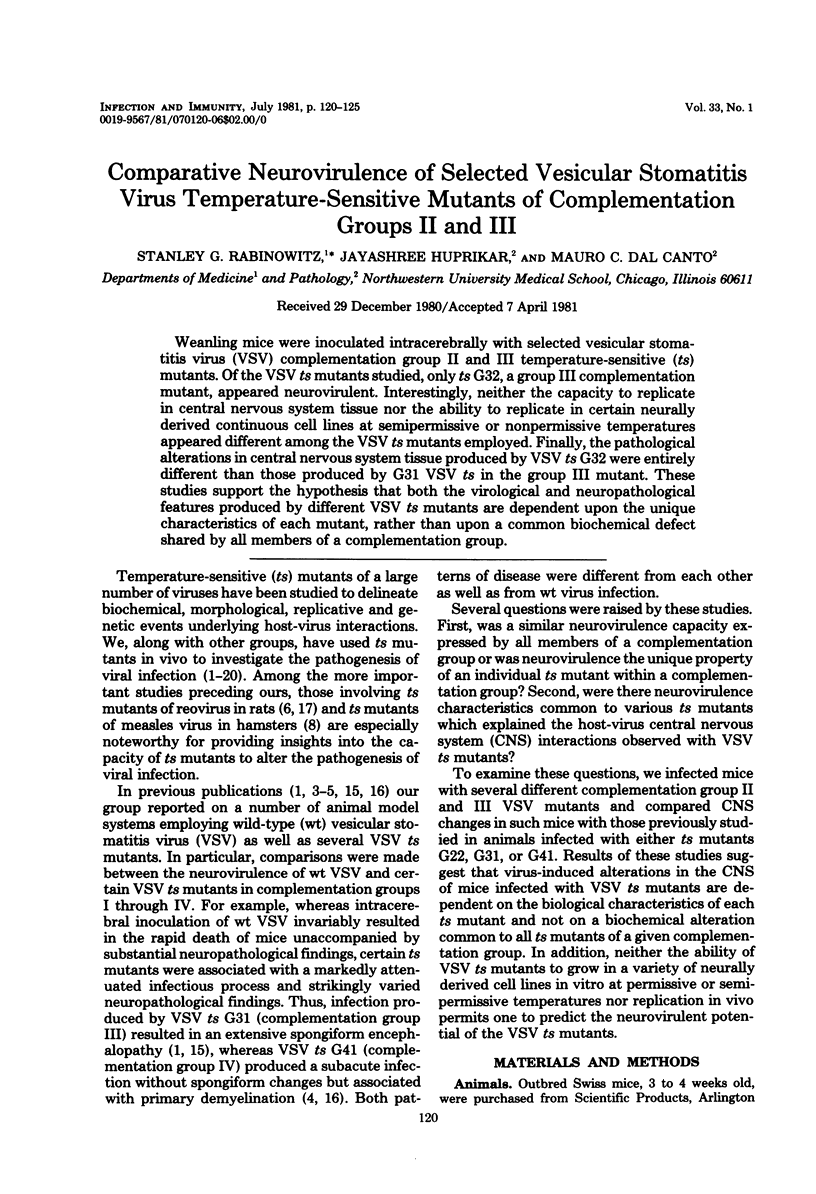
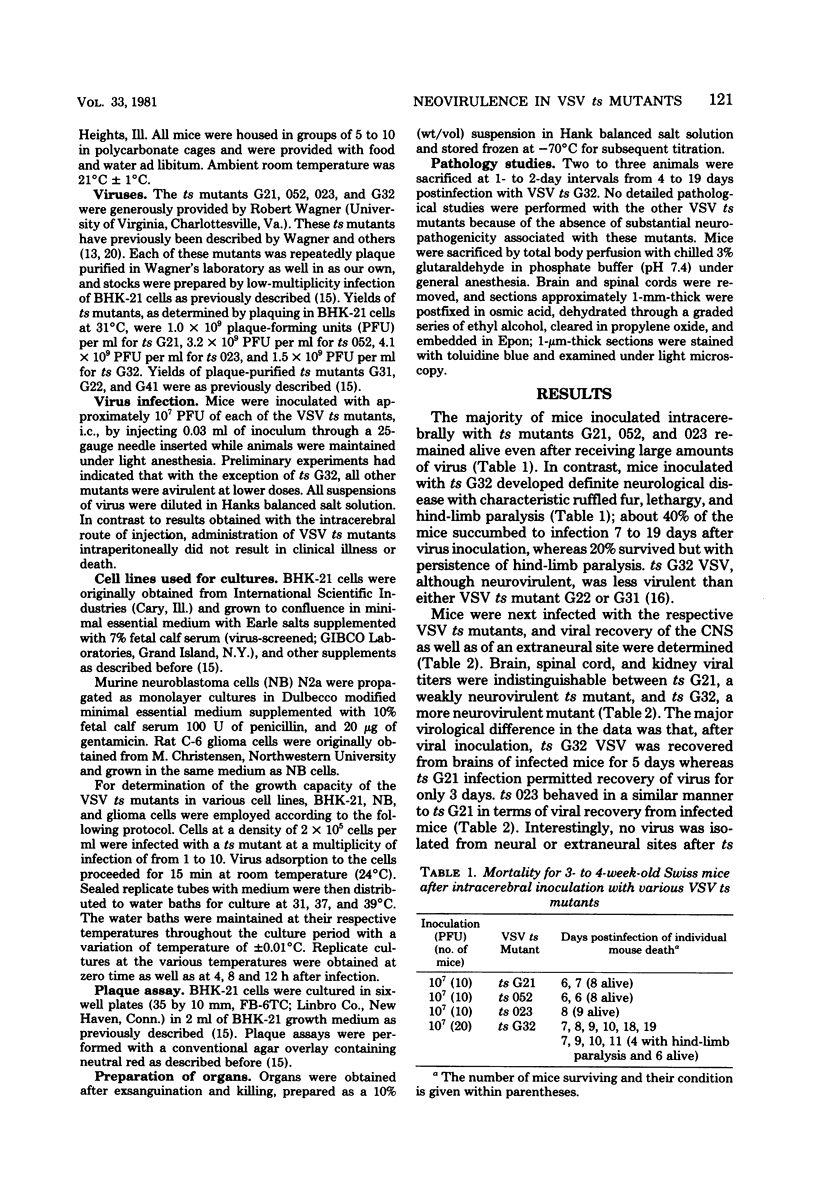
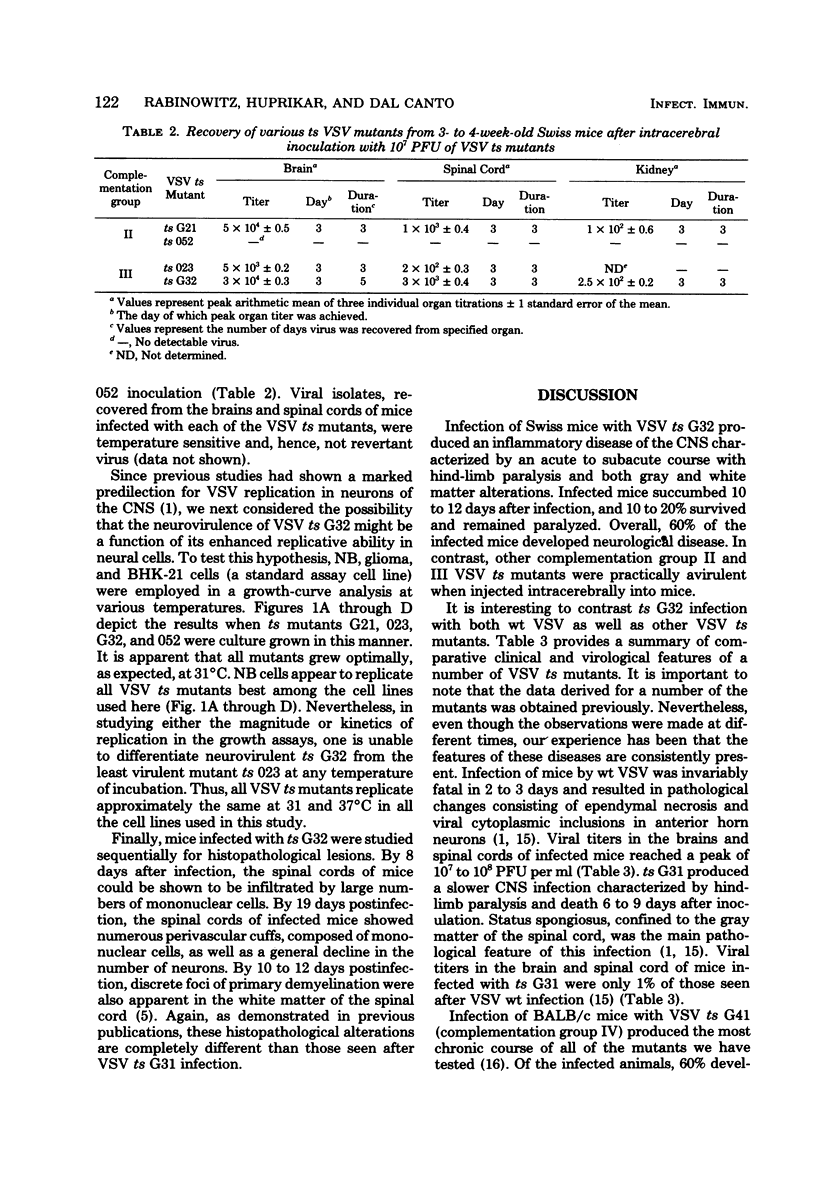
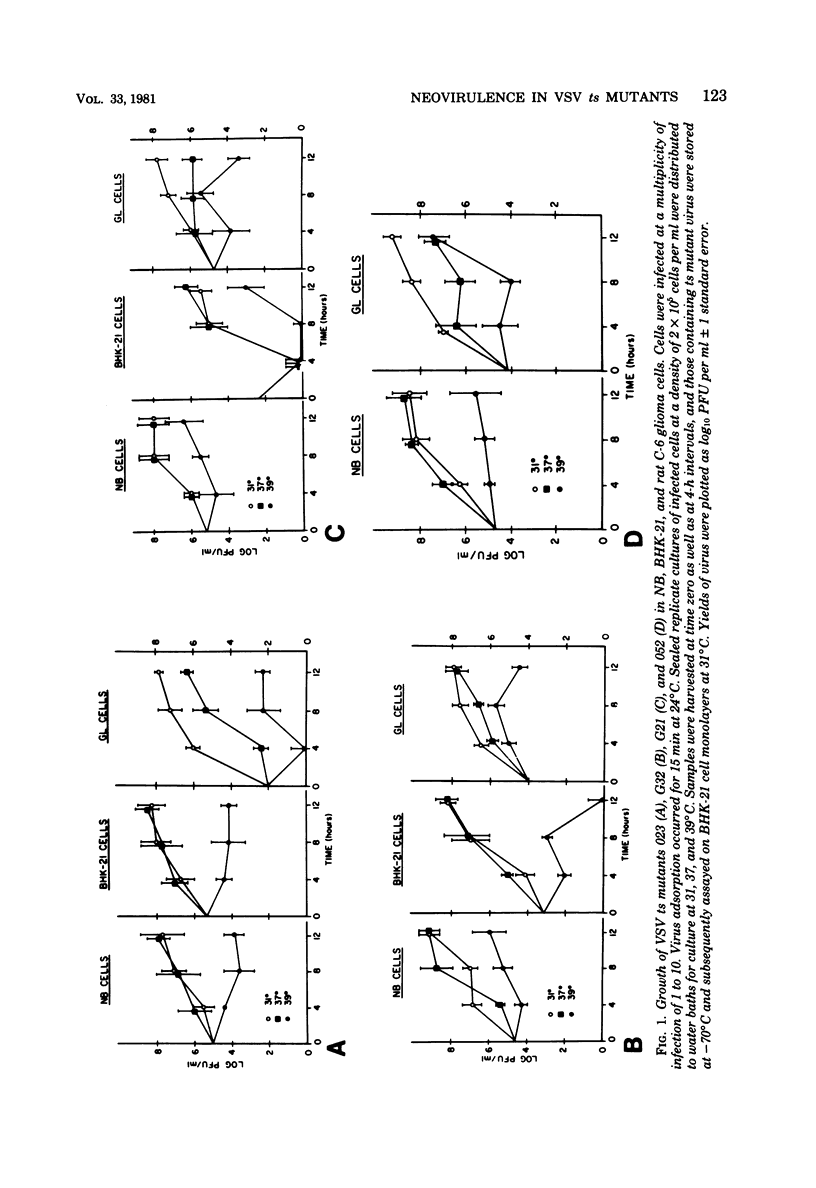
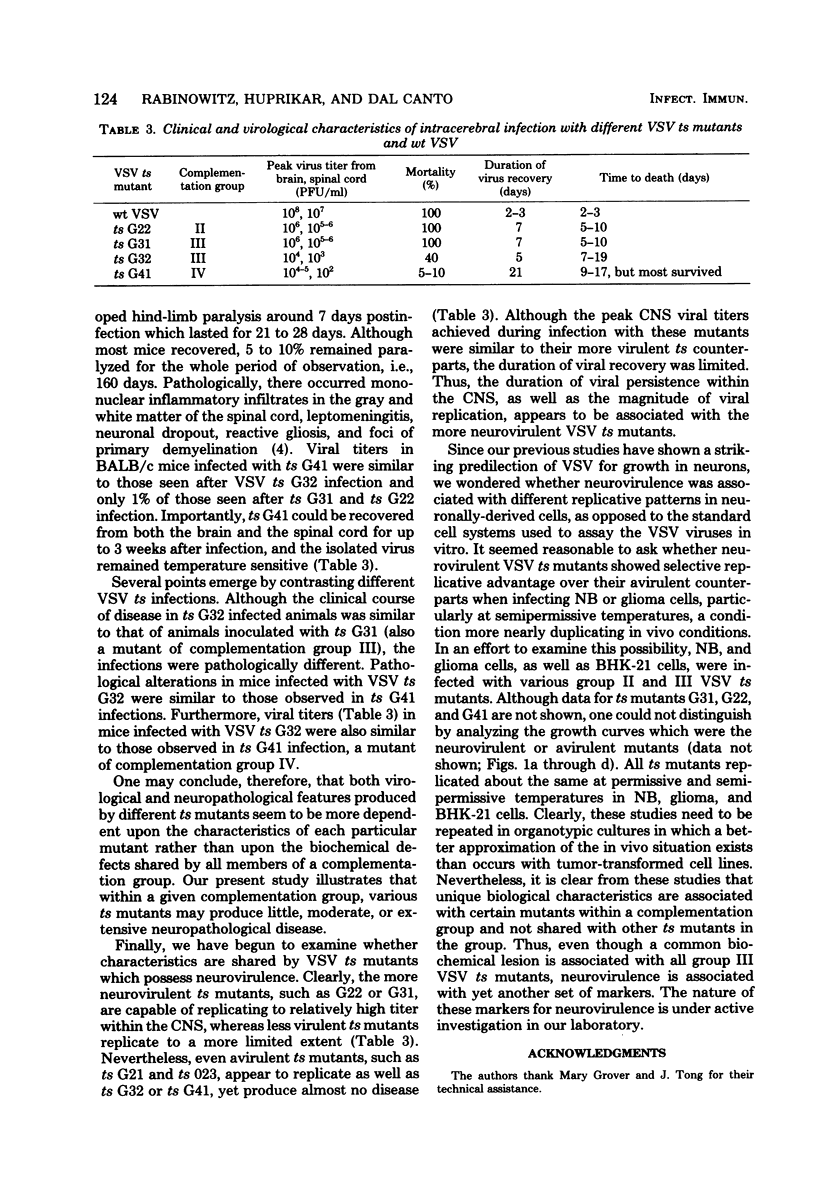
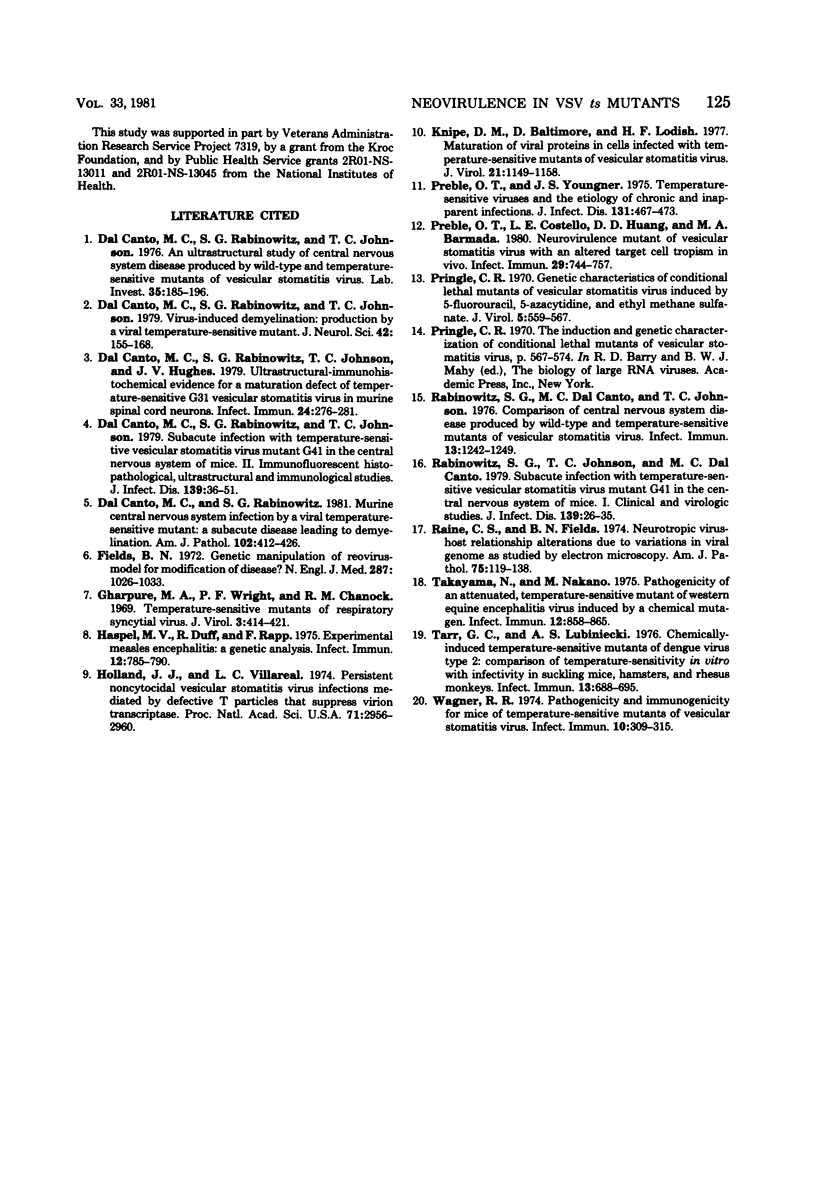
Selected References
These references are in PubMed. This may not be the complete list of references from this article.
- Dal Canto M. C., Rabinowitz S. G., Johnson T. C. An ultrastructural study of central nervous system disease produced by wild-type and temperature-sensitive mutants of vesicular stomatitis virus. Lab Invest. 1976 Aug;35(2):185–196. [PubMed] [Google Scholar]
- Dal Canto M. C., Rabinowitz S. G., Johnson T. C., Hughes J. V. Ultrastructural-immunohistochemical evidence for a maturation defect of temperature-sensitive G31 vesicular stomatitis virus in murine spinal cord neurons. Infect Immun. 1979 Apr;24(1):276–281. doi: 10.1128/iai.24.1.276-281.1979. [DOI] [PMC free article] [PubMed] [Google Scholar]
- Dal Canto M. C., Rabinowitz S. G., Johnson T. C. Subacute infection with temperature-sensitive vesicular stomatitis virus mutant G41 in the central nervous system of mice. II. Immunofluorescent, morphologic, and immunologic studies. J Infect Dis. 1979 Jan;139(1):36–51. doi: 10.1093/infdis/139.1.36. [DOI] [PubMed] [Google Scholar]
- Dal Canto M. C., Rabinowitz S. G., Johnson T. C. Virus-induced demyelination. Production by a viral temperature-sensitive mutant. J Neurol Sci. 1979 Jun;42(1):155–168. doi: 10.1016/0022-510x(79)90159-x. [DOI] [PubMed] [Google Scholar]
- Dal Canto M. C., Rabinowitz S. G. Murine central nervous system infection by a viral temperature-sensitive mutant: a subacute disease leading to demyelination. Am J Pathol. 1981 Mar;102(3):412–426. [PMC free article] [PubMed] [Google Scholar]
- Fields B. N. Genetic manipulation of reovirus--a model for modification of disease. N Engl J Med. 1972 Nov 16;287(20):1026–1033. doi: 10.1056/NEJM197211162872007. [DOI] [PubMed] [Google Scholar]
- Gharpure M. A., Wright P. F., Chanock R. M. Temperature-sensitive mutants of respiratory syncytial virus. J Virol. 1969 Apr;3(4):414–421. doi: 10.1128/jvi.3.4.414-421.1969. [DOI] [PMC free article] [PubMed] [Google Scholar]
- Haspel M. V., Duff R., Rapp F. Experimental measles encephalitis: a genetic analysis. Infect Immun. 1975 Oct;12(4):785–790. doi: 10.1128/iai.12.4.785-790.1975. [DOI] [PMC free article] [PubMed] [Google Scholar]
- Holland J. J., Villarreal L. P. Persistent noncytocidal vesicular stomatitis virus infections mediated by defective T particles that suppress virion transcriptase. Proc Natl Acad Sci U S A. 1974 Aug;71(8):2956–2960. doi: 10.1073/pnas.71.8.2956. [DOI] [PMC free article] [PubMed] [Google Scholar]
- Knipe D. M., Baltimore D., Lodish H. F. Maturation of viral proteins in cells infected with temperature-sensitive mutants of vesicular stomatitis virus. J Virol. 1977 Mar;21(3):1149–1158. doi: 10.1128/jvi.21.3.1149-1158.1977. [DOI] [PMC free article] [PubMed] [Google Scholar]
- Preble O. T., Costello L. E., Huang D. D., Barmada M. A. Neurovirulence mutant of vesicular stomatitis virus with an altered target cell tropism in vivo. Infect Immun. 1980 Aug;29(2):744–757. doi: 10.1128/iai.29.2.744-757.1980. [DOI] [PMC free article] [PubMed] [Google Scholar]
- Preble O. T., Youngner J. S. Temperature-sensitive viruses and the etiology of chronic and inapparent infections. J Infect Dis. 1975 Apr;131(4):467–473. doi: 10.1093/infdis/131.4.467. [DOI] [PubMed] [Google Scholar]
- Pringle C. R. Genetic characteristics of conditional lethal mutants of vesicular stomatitis virus induced by 5-fluorouracil, 5-azacytidine, and ethyl methane sulfonate. J Virol. 1970 May;5(5):559–567. doi: 10.1128/jvi.5.5.559-567.1970. [DOI] [PMC free article] [PubMed] [Google Scholar]
- Rabinowitz S. G., Dal Canto M. C., Johnson T. C. Comparison of central nervous system disease produced by wild-type and temperature-sensitive mutants of vesicular stomatitis virus. Infect Immun. 1976 Apr;13(4):1242–1249. doi: 10.1128/iai.13.4.1242-1249.1976. [DOI] [PMC free article] [PubMed] [Google Scholar]
- Rabinowitz S. G., Johnson T. C., Dal Canto M. C. Subacute infection with temperature-sensitive vesicular stomatitis virus mutant G41 in the central nervous system of mice. I. Clinical and virologic studies. J Infect Dis. 1979 Jan;139(1):26–35. doi: 10.1093/infdis/139.1.26. [DOI] [PubMed] [Google Scholar]
- Raine C. S., Fields B. N. Neurotropic virus-host relationship alterations due to variation in viral genome as studied by electron microscopy. Am J Pathol. 1974 Apr;75(1):119–138. [PMC free article] [PubMed] [Google Scholar]
- Takayama N., Nakano M. Pathogenicity of an attenuated, temperature-sensitive mutant of western equine encephalitis virus induced by a chemical mutagen. Infect Immun. 1975 Oct;12(4):858–865. doi: 10.1128/iai.12.4.858-865.1975. [DOI] [PMC free article] [PubMed] [Google Scholar]
- Tarr G. C., Lubiniecki A. S. Chemically induced temperature-sensitive mutants of dengue virus type 2: comparison of temperature sensitivity in vitro with infectivity suckling mice, hamsters, and rhesus monkeys. Infect Immun. 1976 Mar;13(3):688–695. doi: 10.1128/iai.13.3.688-695.1976. [DOI] [PMC free article] [PubMed] [Google Scholar]
- Wagner R. R. Pathogenicity and immunogenicity for mice of temperature-sensitive mutants of vesicular stomatitis virus. Infect Immun. 1974 Aug;10(2):309–315. doi: 10.1128/iai.10.2.309-315.1974. [DOI] [PMC free article] [PubMed] [Google Scholar]


